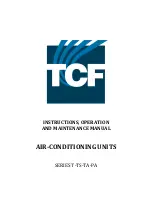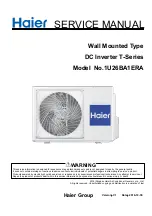
En-
ContEnts
1. BEFORE INSTALLATION ....................................1
2. INDOOR UNIT INSTALLATION ...........................3
3. OUTDOOR UNIT INSTALLATION .......................6
4. PURGING PROCEDURES, LEAK TEST, AND
TEST RUN ...........................................................7
5. PUMPING DOWN ................................................7
1. BEFoRE InstallatIon
1-1. tHE FolloWInG sHoulD alWaYs BE oBsERVED FoR saFEtY
• Be sure to read “THE FOLLOWING SHOULD ALWAYS BE OBSERVED FOR SAFETY” before installing the air conditioner.
• Be sure to observe the warnings and cautions specified here as they include important items related to safety.
• After reading this manual, be sure to keep it together with the OPERATING INSTRUCTIONS for future reference.
1-2. sElECtInG tHE InstallatIon loCatIon
CAUTION
(Could lead to serious injury in particular environments when operated incorrectly.)
Required tools for Installation
Phillips screwdriver
Level
Scale
Utility knife or scissors
25, 35 class 65 mm/50
class 75 mm hole saw
Torque wrench
Wrench (or spanner)
4 mm hexagonal wrench
Flare tool for R410A
Gauge manifold for R410A
Vacuum pump for R410A
Charge hose for R410A
Pipe cutter with reamer
n
Do not install the unit by yourself (user).
Incomplete installation could cause fire, electric
shock, injury due to the unit falling, or leakage of
water. Consult the dealer from whom you purchased
the unit or a qualified installer.
n
Perform the installation securely referring to the
installation manual.
Incomplete installation could cause fire, electric
shock, injury due to the unit falling, or leakage of
water.
n
When installing the unit, use appropriate protec-
tive equipment and tools for safety.
Failure to do so could cause injury.
n
Install the unit securely in a place which can
bear the weight of the unit.
If the installation location cannot bear the weight of
the unit, the unit could fall causing injury.
n
Electrical work should be performed by a quali-
fied, experienced electrician, according to the
installation manual. Be sure to use an exclusive
circuit. Do not connect other electrical appli-
ances to the circuit.
If the capacity of the power circuit is insufficient or
there is incomplete electrical work, it could result in
a fire or an electric shock.
n
Earth the unit correctly.
Do not connect the earth to a gas pipe, water pipe,
lightning rod or telephone earth. Defective earthing
could cause electric shock.
n
Do not damage the wires by applying excessive
pressure with parts or screws.
Damaged wires could cause fire or electric shock.
n
Be sure to cut off the main power in case of set-
ting up the indoor P.C. board or wiring works.
Failure to do so could cause electric shock.
n
Use the specified wires to connect the indoor
and outdoor units securely and attach the wires
firmly to the terminal block connecting sections
so the stress of the wires is not applied to the
sections. Do not extend the wires, or use inter
-
mediate connection.
Incomplete connecting and securing could cause
fire.
n
Do not install the unit in a place where inflam
-
mable gas may leak.
If gas leaks and accumulates in the area around the
unit, it could cause an explosion.
n
Do not use intermediate connection of the
power cord or the extension cord and do not
connect many devices to one aC outlet.
It could cause a fire or an electric shock due to de
-
fective contact, defective insulation, exceeding the
permissible current, etc.
n
Be sure to use the parts provided or specified
parts for the installation work.
The use of defective parts could cause an injury or
leakage of water due to a fire, an electric shock, the unit
falling, etc.
n
When plugging the power supply plug into the
outlet, make sure that there is no dust, clogging,
or loose parts in both the outlet and the plug. Make
sure that the power supply plug is pushed com-
pletely into the outlet.
If there is dust, clogging, or loose parts on the power
supply plug or the outlet, it could cause electric shock
or fire. If loose parts are found on the power supply
plug, replace it.
n
attach the electrical cover to the indoor unit and
the service panel to the outdoor unit securely.
If the electrical cover of the indoor unit and/or the serv-
ice panel of the outdoor unit are not attached securely,
it could result in a fire or an electric shock due to dust,
water, etc.
n
When installing, relocating, or servicing the unit,
make sure that no substance other than the
specified refrigerant (R410A) enters the refriger
-
ant circuit.
Any presence of foreign substance such as air can
cause abnormal pressure rise and may result in
explosion or injury. The use of any refrigerant other
than that specified for the system will cause me
-
chanical failure, system malfunction, or unit break
-
down. In the worst case, this could lead to a serious
impediment to securing product safety.
n
Do not discharge the refrigerant into the atmos-
phere. If refrigerant leaks during installation, venti-
late the room.
If refrigerant comes in contact with a fire, harmful
gas could be generated.
n
Check that the refrigerant gas does not leak
after installation has been completed.
If refrigerant gas leaks indoors, and comes into
contact with the flame of a fan heater, space heater,
stove, etc., harmful substances will be generated.
n
use appropriate tools and piping materials for
installation.
The pressure of R410A is 1.6 times more than R22.
Not using appropriate tools or materials and incom-
plete installation could cause the pipes to burst or
injury.
n
When pumping down the refrigerant, stop the
compressor before disconnecting the refriger-
ant pipes.
If the refrigerant pipes are disconnected while the
compressor is running and the stop valve is open,
air could be drawn in and the pressure in the refrig-
eration cycle could become abnormally high. This
could cause the pipes to burst or injury.
n
When installing the unit, securely connect the
refrigerant pipes before starting the compres-
sor.
If the compressor is started before the refrigerant
pipes are connected and when the stop valve is
open, air could be drawn in and the pressure in the
refrigeration cycle could become abnormally high.
This could cause the pipes to burst or injury.
n
Fasten a flare nut with a torque wrench as speci
-
fied in this manual.
If fastened too tight, a flare nut may break after a
long period and cause refrigerant leakage.
n
the unit shall be installed in accordance with
national wiring regulations.
n
Install an earth leakage breaker depending on
the installation place.
If an earth leakage breaker is not installed, it could
cause electric shock.
n
Perform the drainage/piping work securely ac-
cording to the installation manual.
If there is defect in the drainage/piping work, water
could drop from the unit, soaking and damaging
household goods.
n
Do not touch the air inlet or the aluminum fins
of the outdoor unit.
This could cause injury.
n
Do not install the outdoor unit where small ani-
mals may live.
If small animals enter and touch the electric parts
inside the unit, it could cause a malfunction, smoke
emission, or fire. Also, advise user to keep the area
around the unit clean.
WARNING
(Could lead to death, serious injury, etc.)
ENGLISH
InDooR unIt
• Where airflow is not blocked.
• Where air spreads over the entire room.
• Rigid wall without vibration.
• Where it is not exposed to direct sunshine. Do not
expose to direct sunshine also during the period fol-
lowing unpacking to before use.
• Where easily drained.
• At a distance 1 m or more away from your TV and
radio. Operation of the air conditioner may interfere
with radio or TV reception. An amplifier may be re
-
quired for the affected device.
• In a place as far away as possible from fluorescent
and incandescent lights (so the infrared remote con-
trol can operate the air conditioner normally).
• Where the air filter can be removed and replaced
easily.
REMotE ContRollER
• Where it is easy to operate and easily visible.
• Where children cannot touch it.
• Select the position where the indoor unit can receive
the signal from the remote controller properly. Check
that signals from the remote controller are surely re
-
ceived by the indoor unit from that position (‘beep’ or
‘beep beep’ receiving tone sounds). After that, attach
remote controller holder to a pillar or wall and install
wireless remote controller.
note:
In rooms where inverter type fluorescent lamps are
used, the signal from the wireless remote controller may
not be received.
outDooR unIt
• Where it is not exposed to strong wind.
• Where airflow is good and dustless.
• Where rain or direct sunlight can be avoided as much
as possible.
• Where neighbours are not annoyed by operation
sound or hot air.
• Where rigid wall or support is available to prevent the
increase of operation sound or vibration.
• Where there is no risk of combustible gas leakage.
• When installing the unit at a high level, be sure to
secure the unit legs.
• Where it is at least 3 m away from the antenna of
TV set or radio. Operation of the air conditioner may
interfere with radio or TV reception in areas where re-
ception is weak. An amplifier may be required for the
affected device.
• Install the unit horizontally.
• Please install it in an area not affected by snowfall or
blowing snow. In areas with heavy snow, please in
-
stall a canopy, a pedestal and/or some baffle boards.
note:
It is advisable to make a piping loop near outdoor unit
so as to reduce vibration transmitted from there.
note:
When operating the air conditioner in low outside tem-
perature, be sure to follow the instructions described
below.
• Never install the outdoor unit in a place where
its air inlet/outlet side may be exposed directly to
wind.
• To prevent exposure to wind, install the outdoor
unit with its air inlet side facing the wall.
• To prevent exposure to wind, it is recommended
to install a baffle board on the air outlet side of the
outdoor unit.
Avoid the following places for installation where air
conditioner trouble is liable to occur.
• Where flammable gas could leak.
• Where there is much machine oil.
• Where oil is splashed or where the area is filled
with oily smoke (such as cooking areas and fac
-
tories, in which the properties of plastic could be
changed and damaged).
• Salty places such as the seaside.
• Where sulfide gas is generated such as a hot
spring.
• Where there is high-frequency or wireless equip
-
ment.
• Where there is emission of high levels of VOCs,
including phthalate compounds, formaldehyde,
etc., which may cause chemical cracking.
Model names are indicated in 1-3.
When installing multi units, refer to
the installation manual of the multi
unit for outdoor unit installation.
JG79A867H01_en.indd 1
2014/02/07 15:44:57
Summary of Contents for MFZ-KJ25VE
Page 9: ......
Page 10: ......
Page 11: ......
Page 12: ...HEAD OFFICE TOKYO BLDG 2 7 3 MARUNOUCHI CHIYODA KU TOKYO 100 8310 JAPAN JG79A867H01 ...






























